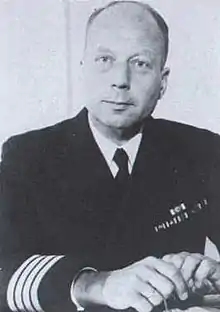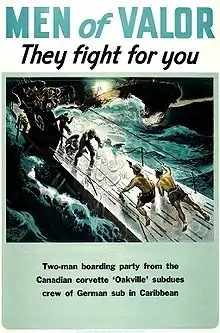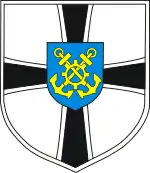Otto Ites
Otto Christian Ites (5 February 1918 – 2 February 1982) was a Kapitänleutnant with the Kriegsmarine during World War II and later a Konteradmiral with the Bundesmarine. He was also a recipient of the Knight's Cross of the Iron Cross (German: Ritterkreuz des Eisernen Kreuzes), the highest award in the military and paramilitary forces of Nazi Germany during World War II.
Otto Ites | |
|---|---|
 Otto Ites | |
| Born | 5 February 1918 Norden |
| Died | 2 February 1982 (aged 63) Norden |
| Allegiance |
|
| Service/ | |
| Years of service | 1936–42 1956–77 |
| Rank |
|
| Unit | |
| Commands held | |
| Battles/wars | |
| Awards | Knight's Cross of the Iron Cross Order of Merit |
| Other work | Dentist |
Career
Otto Ites, born on 5 February 1918 in Norden in the Province of Hanover a Free State of Prussia, joined the military service of the Kriegsmarine on 3 April 1936 as a member of "Crew 36" (the incoming class of 1936). He underwent basic military training in the 2nd department of the standing ship division of the Baltic Sea in Stralsund (3 April 1936 – 13 June 1936).[Tr 1][Tr 2] From 3 April 1938 until 2 October 1939, he served on the torpedo boats Kondor and Albatros in the 4th and 6th Torpedo Boat Flotilla.[1]

Ites served as second watch officer on nine war patrols on U-48, the first five patrols under the command of Herbert Schultze, two patrols under Hans-Rudolf Rösing and two patrols under Heinrich Bleichrodt.[2] Promoted to Oberleutnant zur See on 1 October 1940 and he was made first watch officer on U-48. In this position he went on one more patrol (10 November 1940 – 13 March 1941), U-48 now again under the command of Schultze.
He commanded U-146 and U-94, sinking fifteen ships on seven patrols, for a total of 76,882 gross register tons (GRT) tons of Allied shipping. In September 1941 the Pegasus was torpedoed and all the crew managed to scramble into two lifeboats. One of the lifeboats was rescued but the other was found empty and upside down. The Captain reported that the Pegasus was torpedoed twice, the first one caused quite a lot of damage and the crew left the ship, but then she was torpedoed again and she sank. On 28 August 1942 U-94 was sunk by depth charges in the Caribbean Sea, in position 17°40′N 74°30′W from a Catalina of VP-92 and by the Canadian corvette Oakville. Ites and 25 of his crew were taken prisoner of war. Ites remained in US captivity at Camp Crossville, Tennessee, until 1 May 1946.[3]
After the war Otto Ites matriculated at the University of Bonn in the winter semester 1946/47. He submitted his dissertation on 20 October 1950 at the medical faculty. Dr. Ites joined the military service of the Bundesmarine and as Fregattenkapitän commanded the destroyer Zerstörer 2 (D171), formerly USS Ringgold (DD-500), from November 1960 until September 1962. His twin brother, Oberleutnant zur See Rudolf Ites, commander of U-709, was killed in action on 1 March 1944. U-709 was sunk by depth charges from the US destroyer escorts USS Thomas, Bostwick and Bronstein north of the Azores at 49°10′N 26°00′W.
Summary of career
Ships Attacked
As commander of U-146 and U-94 Otto Ites is credited with the sinking of 15 merchant ships for a total of 76,882 gross register tons (GRT) and damaging one further ship of 8,022 GRT.
* Sailing vessel
Awards
- Iron Cross (1939)
- U-boat War Badge (1939) (21 December 1939)[11]
- Knight's Cross of the Iron Cross on 28 March 1942 as Oberleutnant zur See and commander of U-94[12][13]
Promotions
| Kriegsmarine | |
|---|---|
| 10 September 1936: | Seekadett (naval cadet)[1] |
| 1 May 1937: | Fähnrich zur See (midshipman)[1] |
| 1 July 1938: | Oberfähnrich zur See (senior midshipman)[1] |
| 1 October 1938: | Leutnant zur See (acting sub-lieutenant)[1] |
| 1 October 1940: | Oberleutnant zur See (sub-lieutenant)[11] |
| 1 April 1943: | Kapitänleutnant (captain lieutenant/lieutenant)[11] |
| Bundesmarine | |
| 4 January 1956: | Korvettenkapitän (corvette captain/lieutenant commander)[11] |
| 25 August 1959: | Fregattenkapitän (frigate captain/commander)[11] |
| 17 December 1964: | Kapitän zur See (captain at sea/captain)[3] |
| 2 April 1971: | Flottillenadmiral (flotilla admiral)[3] |
| 1 April 1975: | Konteradmiral (rear admiral)[3] |
Translation notes
- 2nd department —II. Abteilung
- standing ship division —Schiffsstammdivision
References
Citations
- Busch & Röll 2003, p. 206.
- Busch & Röll 2003, pp. 206–207.
- Busch & Röll 2003, p. 208.
- Rohwer 1999, p. 58.
- Rohwer 1999, p. 65.
- Rohwer 1999, p. 68.
- Rohwer 1999, p. 87.
- Rohwer 1999, p. 95.
- Rohwer 1999, p. 101.
- Rohwer 1999, p. 102.
- Busch & Röll 2003, p. 207.
- Fellgiebel 2000, p. 240.
- Scherzer 2007, p. 414.
Bibliography
- Busch, Rainer; Röll, Hans-Joachim (2003). Der U-Boot-Krieg 1939–1945 — Die Ritterkreuzträger der U-Boot-Waffe von September 1939 bis Mai 1945 [The U-Boat War 1939–1945 — The Knight's Cross Bearers of the U-Boat Force from September 1939 to May 1945] (in German). Hamburg, Berlin, Bonn Germany: Verlag E.S. Mittler & Sohn. ISBN 978-3-8132-0515-2.CS1 maint: ref=harv (link)
- Fellgiebel, Walther-Peer (2000) [1986]. Die Träger des Ritterkreuzes des Eisernen Kreuzes 1939–1945 — Die Inhaber der höchsten Auszeichnung des Zweiten Weltkrieges aller Wehrmachtteile [The Bearers of the Knight's Cross of the Iron Cross 1939–1945 — The Owners of the Highest Award of the Second World War of all Wehrmacht Branches] (in German). Friedberg, Germany: Podzun-Pallas. ISBN 978-3-7909-0284-6.CS1 maint: ref=harv (link)
- Milner, Marc (2011). Battle of the Atlantic. The History Press. ISBN 978-0-7524-6187-8.CS1 maint: ref=harv (link)
- Morgan, Daniel; Taylor, Bruce (2011). U-Boat Attack Logs: A Complete Record of Warship Sinkings from Original Sources, 1939–1945. Seaforth Publishing. ISBN 978-1-84832-118-2.CS1 maint: ref=harv (link)
- Rohwer, Jürgen (1999). Axis submarine successes of World War Two: German, Italian, and Japanese submarine successes, 1939-1945. Greenhill Books. ISBN 978-1557500298.CS1 maint: ref=harv (link)
- Scherzer, Veit (2007). Die Ritterkreuzträger 1939–1945 Die Inhaber des Ritterkreuzes des Eisernen Kreuzes 1939 von Heer, Luftwaffe, Kriegsmarine, Waffen-SS, Volkssturm sowie mit Deutschland verbündeter Streitkräfte nach den Unterlagen des Bundesarchives [The Knight's Cross Bearers 1939–1945 The Holders of the Knight's Cross of the Iron Cross 1939 by Army, Air Force, Navy, Waffen-SS, Volkssturm and Allied Forces with Germany According to the Documents of the Federal Archives] (in German). Jena, Germany: Scherzers Militaer-Verlag. ISBN 978-3-938845-17-2.CS1 maint: ref=harv (link)
External links
- Otto Ites in the German National Library catalogue
- Helgason, Guðmundur. "Otto Ites". German U-boats of WWII - uboat.net. Retrieved 15 April 2015.
- BBC
| Military offices | ||
|---|---|---|
| Preceded by Fregattenkapitän Günter Kuhnke |
Commander of German destroyer Z-2 (formerly USS Ringgold) December 1960 – September 1962 |
Succeeded by Fregattenkapitän Paul Brasack |
| Preceded by Konteradmiral Günter Luther |
Chief of the Navy Office 1 April 1975 – 30 September 1977 |
Succeeded by Konteradmiral Horst Geffers |

